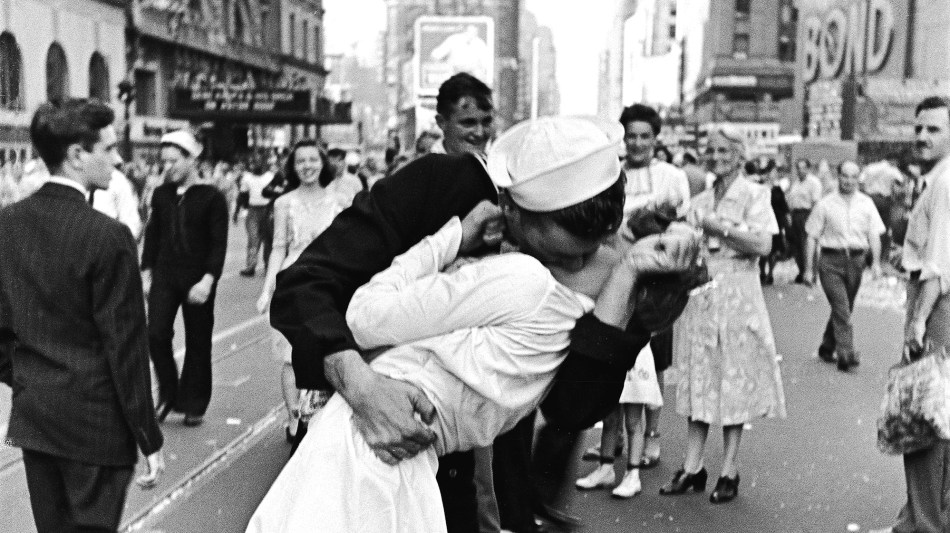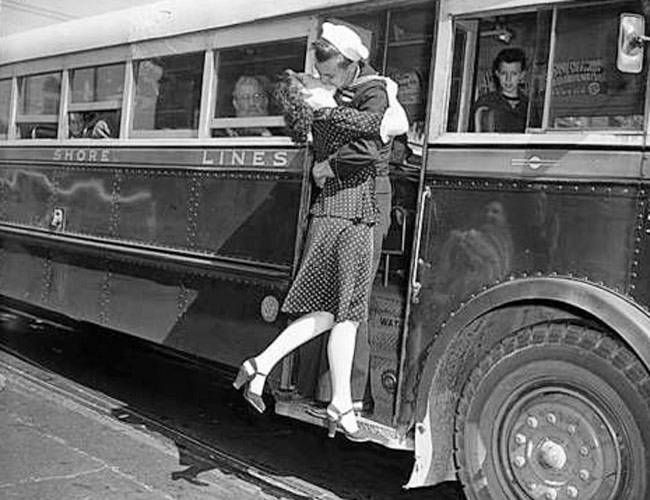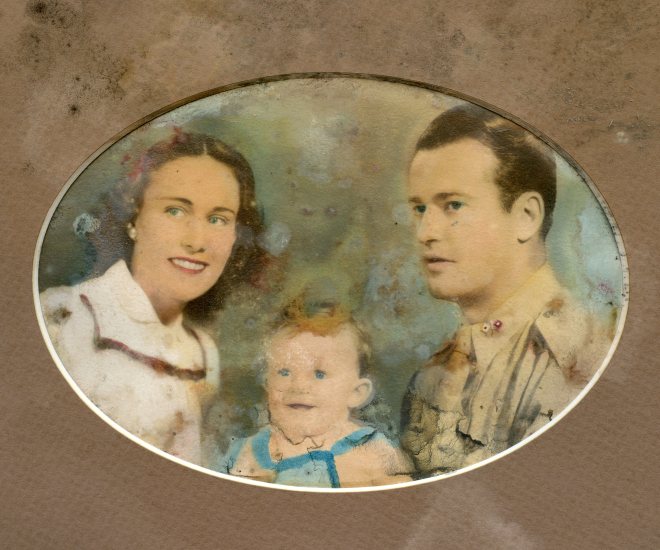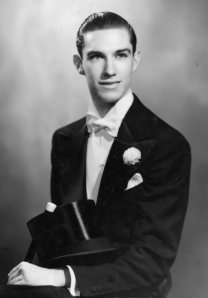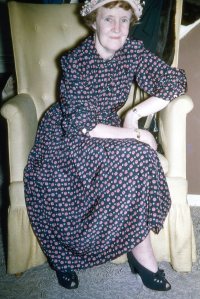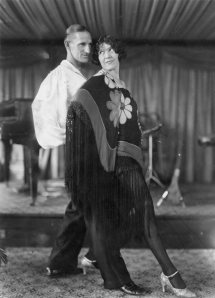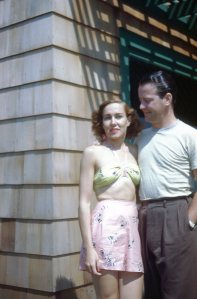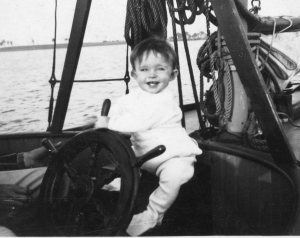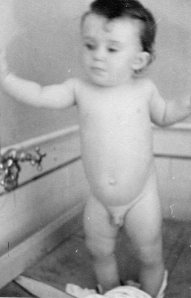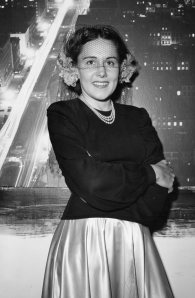MY TEN FAVORITE WORKS OF NON FICTION
MY TEN FAVORITE WORKS OF NON FICTION
(About half way through writing this, I became aware that these books are all about war and politics)
Douglas Southall Freeman….. ROBERT E. LEE….. And his equally extraordinary three volume work – LEE’S LIEUTENANTS: A STUDY IN COMMAND……..MANASSAS TO MALVERNE HILL, CEDAR MOUNTAIN TO CHANCELLORSVILLE, and GETTYSBURG TO APPOMATTOX. Just about the entire Civil War from The Army of Northern Virginia’s point of view. This is a magnificent series of volumes, and you’ll be a better human being having read them.
Neil Sheehan…..A BRIGHT SHINING LIE…..The one volume that explains America’s involvement in Vietnam so much better than all the rest. Sheehan covered Vietnam as a war correspondent and wrote with a rare intimacy of the characters on both sides.
Winston Churchill…..THE SECOND WORLD WAR…..Of the thousands of books written about the war, Churchill’s perspective is unique, as is his ability as a writer.
William Shirer…..THE RISE AND FALL OF THE THIRD REICH…..The Germans are notorious record keepers, and their massive chronicle of Nazi Germany’s birth, its criminal war machine, and its ultimate end were captured by the Allies before they could be destroyed. Shirer had unique access to the mountains of material, and his thousand page volume is probably the most complete record of a major nation’s rise and fall ever compiled.
Bruce Catton…..THE ARMY OF THE POTOMAC…..This is a three volume work:
MR. LINCOLN’S ARMY, GLORY ROAD and A STILLNESS AT APPOMATTOX. Lincoln’s problem was that his Generals did not want to fight their West Point schoolmates, who were now commanding the Confederate Army. Catton’s chronicle is an intimate and perceptive look at the Civil War from the Union’s point of view.
Norman Mailer…..MIAMI AND THE SEIGE OF CHICAGO…..1968 and the Republican and Democratic national conventions. The republican love-fest in Miami, and the conflagration that took place in Chicago. How did it happen? Who was to blame? Mailer’s book is exhausting and deeply satisfying. He was born to write this chronicle. I’ve read it three times, learning something new each time. Mailer’s talent as a story teller is unique.
David Halberstam…..THE BEST AND THE BRIGHTEST…..The brilliant men who involved America in Vietnam, and kept her there. Robert McNamara, McGeorge Bundy, Dean Rusk, George Ball, William Westmorland, and Presidents Kennedy and Johnson. How is it possible? The handwriting was on the wall, and it was ignored. Halberstam’s book is a revelation.
Robert Caro…..THE YEARS OF LYNDON JOHNSON/THE PATH TO POWER…..This is the first volume of three about LBJ, and probably the most intimate chronicle of Johnson’s life and career, from the Texas hill country to the Halls of Congress. A unique look at a fascinating man.
Carl Bernstein and Robert Woodward…..ALL THE PRESIDENT’S MEN…..Two young newspaper reporters who brought down a Presidency. It’s been too many years since I read this. Time to read it again. We all know the story, but how many of us have read the book. Why did Nixon do it? It made no sense. The senior writers on the Washington Post all wanted a piece of this, once the story developed, but Bradley stuck with “The Boys”. A fabulous story.
James McPherson……THE BATTLE CRY OF FREEDOM….. If the three volume sets, listed above by Freeman and Catton, seem like too exhausting a chore, and you were looking for a single volume that explains the Civil War, from the perspective of both sides, McPherson’s chronicle fully integrates political, social, and military events that crowded the two decades, from the outbreak of the war in Mexico to the ending of another at Appomattox. A solid piece of Nineteenth century history.
© 2020 Shaun Costello
THREE GREAT LOVE SONGS FROM WORLD WAR TWO
THREE GREAT LOVE SONGS FROM WORLD WAR TWO
Separation is the common theme – listened to by wives and sweethearts on the home front, and by husband and lovers, overseas in distant lands fighting in the war. A horrific, yet romantic time, and these three songs must have helped and hurt in equal measure. And they’re lovely indeed. I remember these three vividly because my mother used to sing them around the house, and play them on the record player when I was a small child.
YOU’LL NEVER KNOW…1943
Music by Harry Warren and Lyrics by Mack Gordon
The hit recording was by British songbird Vera Lynn.
https://www.youtube.com/watch?v=JZtWNlCTc6o
I’LL BE SEEING YOU…1944
Music by Sammy Fain and Lyrics by Irving Kahal
Originally written in 1938, but made famous in the 1944 movie I’LL BE SEEING YOU, which made it a big hit, and one of WWII’s great love songs.
https://www.youtube.com/watch?v=nvq4OnhMEO4
IT’S BEEN A LONG, LONG TIME…1945
Music by Jule Styne and Lyrics by Sammy Cahn
The hit recording was by Harry James and vocalist Kitty Kallen
https://www.youtube.com/watch?v=Rkeh50Nig5U
*
© 2018 Shaun Costello
HAIL THE CONQUERING HERO

HAIL THE CONQUERING HERO
by Shaun Costello
This story becomes Chapter One (following the prologue)
of the childhood memoir:
THE LAST TIME I SAW JESUS
Surviving God and Elvis in the Time of ‘Duck and Cover’
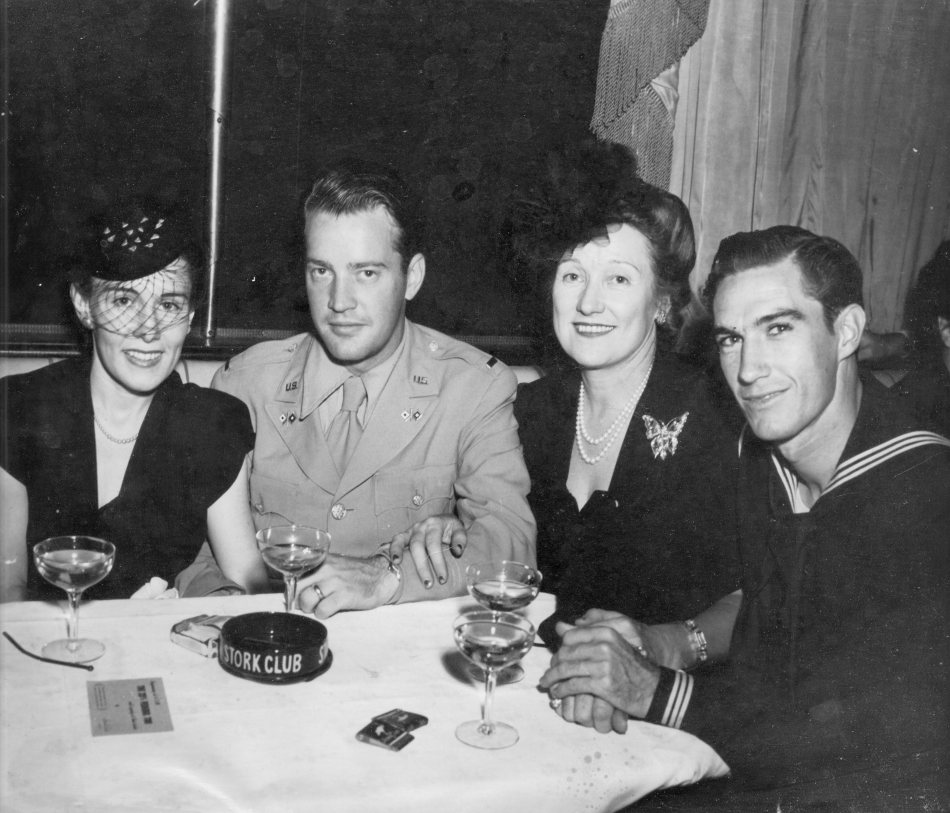
My newlywed parents, along with my Aunt Alice and Uncle Tommy, at The Stork Club, a few weeks before my father left for The Pacific during World War II
As a child, I had two adult male role models, neither of whom, as far as I know, experienced a single responsible moment in their lives; which goes a long way toward explaining why money has always been a mystery to me. There was my father – a pathological liar, degenerate gambler, alcoholic, chain smoker, and raconteur to the uninformed; who seemed involved in an endless struggle between his income and the image of himself he had created, with clumsy sleight-of-hand, as a buffer to prevent being discovered as the fraud he must have known in his heart he undoubtedly was.
And then there was my Uncle Tommy, who staked his claim to my affections during the waning months of World War II, while my father was off serving in the Pacific, and then with the occupation forces after the Japanese surrender. Uncle Tommy was movie star handsome and a professional dancer, who parlayed this combination of useful traits, regardless of the fact that he was homosexual, into a lifetime of living off the gifts of generous and very wealthy women, whose ranks included Woolworth heiress Barbara Hutton.
Quite understandably, my father resented my uncle, who lavished expensive gifts upon his favorite nephew, made his gift-laden visits to our family driving his Rolls Royce, and occasionally took us cruising on his yacht. My friends would gather outside our house as the trunk to Uncle Tommy’s Rolls would open like a cornucopia of generosity, the gifts flowing, while my father watched from our living room window, properly fortified with yet another VO Manhattan against the onslaught of familial competitiveness, a turf war he had no chance of winning. I thought Uncle Tommy was rich – the Rolls, the yacht, the custom tailored suits; but I’m willing to bet that, for all his lavish behavior, Uncle Tommy never had a bank account containing more than a hundred dollars. Neither my father nor my uncle spent any time planning for their futures. They couldn’t be bothered. They both lived in the smoke they had created around their respective ever-precious present. They had tricks up their sleeves. They did it with mirrors – an endless hocus-pocus. They both died broke.
On the surface, my family seemed to be living out the post war, Robert Moses version of the American Dream – Father, mother, brother, sister, dog and station wagon; all ensconced in the suburban subdivision of Green Acres, a delightfully park-like, child-friendly community, in Long Island’s Nassau County – about a forty minute car ride from midtown Manhattan.
We lived in a two story brick house that was identical to every fourth house in the community, Green Acres offering four designs to choose from. This meant that on Elderberry Lane, which had a total of fourteen houses, our house was repeated three or four times, pretty typical in post World War II cookie-cutter subdivisions. Sounds a bit like Baltimore, but, despite architectural similarities, people seemed to find their way to their own houses unaided, with the exception of my philandering father, who was often accused by my mother of spending just a bit too much time offering domestic assistance to neighboring housewives, which was the cause of many interruptions in our familial tranquility. Virtually all of the streets in Green Acres were cul-de-sacs, which meant no through-traffic, or paradise to a kid on a Schwinn. Sections of the community were separated by small parks, so that you could walk from one end to the other without crossing a single street, allowing our extremely eccentric Dachshund ‘Ronzoni’ to wander freely about the neighborhood, sometimes for days at a time.
And then there was Montauk. In the late 1930’s, some members of my mother’s family, siblings of mygrandmother, bought property in Montauk, which was then a small fishing village at the very Eastern tip of Long Island, about a hundred miles East of Manhattan. These were the Stephensons, the children of my great grandmother Kitty Lane, who married Edward Stephenson, whose photograph, for decades after his early demise, sporting a straw skimmer and handlebar mustache, adorned the wall of their family’s Bronx apartment.

The Stephensons visit us in Green Acres. It was my Great Grandmother’s 85th birthday. She’s in the back next to little Shaun.
They were blue collar, working class, depression era Irish, bringing to the table all the good and the bad that that combination of unfortunate circumstances might suggest. With the exception of Aunt Catherine, I found them to be likeable and exotic. They seemed to speak another language, pronouncing words differently than I had ever heard before. Oil was earl, as in, “I’ve got to put some motor earl in the car”, or, “Pick up some olive earl for salad.” They called Chinese food chinks, and pizza was ahbeetz. Their apartment in the Bronx was filled with strange and bewildering religious oddities, each room with a crucifix on the wall and framed pictures of Jesus, the Virgin Mary, and various Saints. And there were glow-in-the-dark statues, mostly of Jesus that, if held next to a lamp for a minute or so, would glow a strange blue-green. On my Great Grandmother’s dresser was Statue of Jesus with little doors built into his chest which, when opened, revealed all his internal organs, like an illustration in a biology book. I had no idea why Jesus would want to share his internal organs with me, but examining the sacred innards was so wonderfully weird that it became my favorite source of amusement whenever we paid a visit.
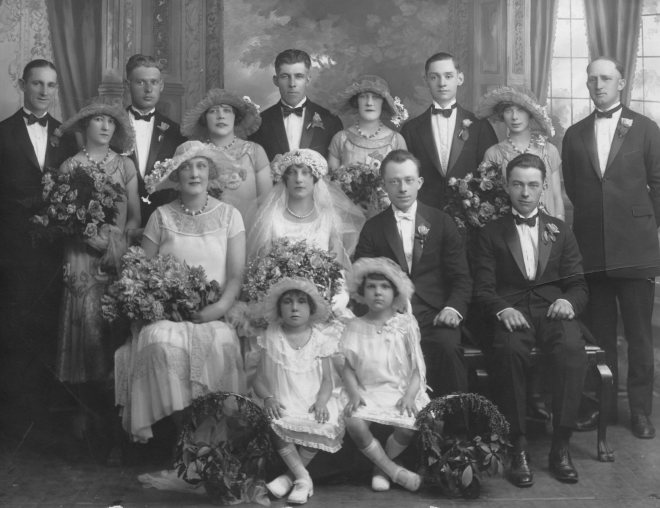
My Aunt Catherine and Uncle Harold’s wedding portrait. They don’t make silver prints like this any more, It’s truly beautiful.
The oldest Stephenson was Edward Junior (Uncle Eddie) who, although his Montauk cottage sat directly across the .street from his younger sister Catherine, had, some time between the purchase of his building lot in the mid 1930’s, and the end of World War II, engaged in some dispute with his siblings, a result of which was eternal and mutual banishment. His sisters seldom spoke his name, and then only accompanied by a shaking head and mournful sigh – an Irish form of familial excommunication. As a small child I saw him once or twice, but was discouraged from crossing the dirt road that separated the warring parties.
The next in line was my Great Aunt Rose, a stout, determined woman, who lived far outside the code of conduct normally adhered to by her peers. Some time in the early 1920’s, Rose divorced her husband, and married Charlie Volk, a Jewish soda vendor with whom she had been carrying on a delightfully disgraceful affair for quite some time. Among depression era Irish, divorce was unthinkable. And marrying a Jew, well, the whole neighborhood probably grabbed their rosary beads and fell to their knees in a desperate attempt to prevent Bronx-bound lightening strikes. Rosie drank whiskey in bars, and enjoyed the company of men. Rosie got into bar fights that she usually finished. Rosie had some cojones.
Then came Aunt Della, a small, thin, mousy little woman, who, it was rumored, suffered a terrible bout of tuberculosis in her early twenties, which kept her chair-bound for most of her life, but didn’t seem to deter her chain smoking. Della married a man named Clem who, during prohibition, succumbed to a lethal combination of bad clams and bathtub gin. He walked out of the clam bar on City Island with a smile on his face, and was dead two hours later. There were whispers about Aunt Della that my young ears detected, but that my child’s brain could make little sense of. Something about a tubal pregnancy. A dead fetus inside Aunt Della. A shameful secret. Hair that kept growing. Different lengths were mentioned – three feet, five feet, ten feet – all inside Aunt Della. Until finally, she could hide her delicate dilemma no longer, and off to the hospital she went, to have her expanding Medusa surgically removed from her Catholic self. I assume it was the offspring of the deceased clam eater, but I guess we’ll never know.
Next was Anna (Nan), my Grandmother, who flew the coop at an early age, and married notorious gambler, and stage performer Black Jack Dowling. They started a Vaudeville act, had two kids (my Mother and Uncle Tommy), added them to the act, and called themselves the Dancing Dowlings. They played the Southern Vaudeville circuit for about ten years, before returning to New York City. Unlike the rest of her siblings, Nan lived in Manhattan for most of her adult life.
Last and probably least, was Aunt Catherine, the baby of the Stephenson clan. She bore a startling resemblance to Margaret Hamilton, who played the wicked witch in the Wizard of Oz. Catherine was married to Harold Hanley (Uncle Harold or sometimes Bootsiboo – don’t ask) who was a construction foreman, flounder fisherman, and pretty affable guy. How he put up with all those old biddies is anybody’s guess. Catherine was an unpleasant woman who couldn’t resist pinching my cheek, which really hurt. I hid from Aunt Catherine.
In the early days of World War II, Aunt Catherine and Uncle Harold built a tiny cottage on their Montauk property, and their presence seemed to draw other family members out to the end of Long Island. Uncle Tommy, who worked on the Tars and Spars Shows, out of the Brooklyn Coast Guard Barracks, began taking weekend passes, along with his Coast Guard pals, and heading out to Montauk, where he had befriended Otto and Mary Steinfeld, who owned the Montauket Hotel. After the war, Sonny Volk, Rosie’s son, who had lost a leg in the Battle of the Bulge, settled in Montauk, looking for business opportunities.
In January of 1946 my world, as I knew it, would change forever with the return of my father from Japan. Hail the conquering hero. He was resplendent in his army uniform, shiny Captain’s bars adorning the epaulets on his shoulders, and I’m sure a great fuss was made over him by everyone he knew, or was introduced to. This would be the first time I laid eyes on my father, who was on a troop ship sailing to New Guinea when I was born. Up until then, having a father, in my little world, meant being told stories by my mother of her hero, off somewhere far away, fighting for America.
She would show me pictures and read me letters, and drag me to the record store where we would sit in a booth and record our voices on a disc that she would send off to somewhere in the far Pacific, to be listened to by her husband and his army pals. Personal recordings were extremely popular during the war, where many, like my father, could listen to the voices of their wives and sweethearts, and children they had yet to meet. I was two when I first met him, and I’m sure that his sudden presence in my life was bewildering, to say the least. He moved in to the small apartment I had shared with my mother, on Creston Avenue in the Bronx. My mother told me years later that she made my father wear his uniform after his return so she could show him off to everyone she knew. Take him down to the Club Fordham and flaunt her victorious soldier to the gang. He was a handsome guy, and I’m sure my mother’s pals were impressed by those shiny Captain’s bars on his shoulders.
A few years later, while snooping through his army trunk, which was one of my favorite forms of rainy day adventure, I came across his discharge papers. They were right there, along with his uniforms, and souvenirs of his years in the Pacific; a samurai sword, a blood-stained Japanese flag allegedly taken from the pockets of a dead enemy soldier, ivory Buddha statues, sea shells, photographs of naked women, and the various and sundry collected keepsakes of two years in a distant land. First Lieutenant Albert W. Costello was Honorably Discharged…………First Lieutenant. This would be my first brush with my father’s sleight-of-hand. He must have purchased Captain’s Bars at the PX, and somewhere between exiting the troop ship, and being enveloped into the welcoming arms of my mother, Lieutenant Costello became a Captain. I guess his army rank disappointed him, but more importantly, he thought it might disappoint others. I never mentioned my discovery, which I’m quite certain my mother was unaware of. The uniform finally went into mothballs, replaced by custom tailored suits, but the story of Al being a Captain in the war became his permanent legacy.
It wasn’t until my family moved to Green Acres that we began our visits to Montauk. After the birth of my sister, my father, looking for more space for his growing family, and greener pastures for his fragile self-esteem, moved us from our tiny Bronx apartment to the town of Katonah, in the wilds of northern Westchester County, a two and a half hour commute by train to his office in mid-town Manhattan. He had rented a house on a lovely estate called Blue Spruce Farm, overlooking the Croton Reservoir. The property, owned by a mysterious man named Korhulse, was extensive – fields, woods, ponds, streams, barns containing horses, empty buildings in which to do make-believe and exploring – what a place to be a kid. The literally thousands of family photographs I inherited tell a story of countless visits by many of my father’s friends from the city, who made the trek north to our house in the country, to witness, first hand, the kind of life style Al Costello now enjoyed. But, after two years, the length of the commute, and the lure of participation in the American Dream’s reward of home ownership, overwhelmed my father, who decided to buy a house on Long Island. I was told quite abruptly, half way through kindergarten, and was uprooted, and dragged kicking and screaming to the enclave of Green Acres, a short commute to my father’s office, and the first home my family actually owned.
We now lived less than a hundred miles from the hamlet of Montauk, where family members owned houses, and others like my Uncle Tommy were now visiting fairly often. It didn’t take long before we began stuffing ourselves and our baggage in our Nash Rambler station wagon to make weekend trips east.
My father took to Montauk like the return of the prodigal son, although I’m not sure why. He wasn’t a fisherman, being a bit too squeamish to gut a freshly caught flounder. Boating made him sea sick. He was prone to sun burn. Yet, according to all who witnessed Al Costello’s Montauk epiphany, the man just loved the place. Early attempts at staying with Aunt Catherine, Uncle Harold and all the old biddies in their tiny cottage were quickly exchanged for rooms in local hotels. There was Bill’s Inn on Fort Pond, and The Montauk Chalet in a place called Shepherd’s Neck, and finally cottages in Hither Hills overlooking the ocean that were owned by a family named French. The Frenches were friends of my Uncle Tommy, who recommended we stay there.
The French family owned considerable property in an area of Montauk called Hither Hills, which sat directly above the ocean beaches and, many decades later, would become the most valuable real estate on the East Coast. Richard Nixon, who, while staying at Gurney’s Inn, an ocean front hotel in Hither Hills, wrote his acceptance speech for his nomination as the Republican candidate for President in 1968. Nixon was so taken with Hither Hills that, after his inauguration as President, he attempted to have the government purchase the property adjacent to Gurney’s Inn, with the intention of constructing the Nixon Summer White House. The Secret Service put the kibosh on Nixon’s plans because of security concerns, the property being too visibly accessible from the ocean.
The familial competition between my father and uncle rekindled when the Frenches persuaded my Uncle Tommy to purchase ocean front property adjacent to their own. Uncle Tommy’s always-prosperous appearance deceived the Frenches into thinking he could afford it. Unable to actually buy the property, and unwilling to be found out as a mountebank and charlatan, my uncle somehow wrangled an option to purchase the land with a small down payment, which could only have come from one of his many dowager patrons.
No one but Uncle Tommy knew this, of course, everyone assuming that he was now the proud owner of some very expensive real estate. This was disturbing news to my father, who had recently purchased, on a G.I. mortgage, our house in Green Acres, and was almost certainly financially overextended. Not to outdone by his brother-in-law, and ignoring his financial reality, the ignoble Army Captain found himself a willing real estate agent, and began looking for a suitable site for the Costello family’s new summer house.
Within a year, Al Costello found himself making mortgage payments on our home in Green Acres, and our new summer house in Montauk. My father was now living way beyond his means, the two mortgages added to his ever-increasing gambling debts, and, unknown to the rest of us, was drowning in a whirlpool of fantasy-driven irresponsibility, robbing Peter to pay Paul, and struggling to somehow keep his head above water.

Our eccentric Daschound Ronzoni outside our house in Montauk. Uncle Tommy’s Jaguar Mark IX in background.
Meanwhile, Uncle Tommy, unable to make any additional payments on his ocean front fiasco, lost his option to purchase the property. Somehow, no one found out about this real estate calamity, and his friends and family went right on thinking, for many years, that Thomas Dowling Esquire owned that ocean front property, a myth he enthusiastically encouraged. After all, in his custom tailored suits, driving his Jaguar Mark IX sedan, gifts lavished upon him by generous women, he certainly looked the part.
My mother, now ensconced in her Green Acres dream house, spending weekends splashing about on the beaches near her newly acquired summer home, was unaware of her husband’s financial difficulties, at least in the beginning. But financial pressures quickly eat away at marital stability, and within a short time my parents’ marriage became out and out warfare, my sister and I hiding under our beds during bouts of shouting, name calling, and dish throwing; the argument usually started by my father, who was by then stopping off for a few quick ones on his way home to face the family he now blamed for his dilemma. I remember one horrific incident, when my father came home quite late and obviously drunk, ignoring the dinner set on the dining room table, and staggering to his room where he collapsed in bed. My mother was so enraged that, for reasons known to her alone, she took all of the dishes off the table and smashed them against the living room wall which, by the time she had thrown her last projectile, was completely covered by dripping food, and broken fragments of china, a violent and terrifying image I can still recall vividly.
Our family was in jeopardy. Revealed to me many years later, my father uncharacteristically confessed his situation, even the gambling debts, to my mother. A change had to be made, and it had to be made quickly. One of the houses had to be sold, and my parents decided to sell our home in Green Acres, and hold on to, at least temporarily, the Montauk beach house. Leaving Green Acres was probably the most traumatic moment of my childhood, and I never really forgave my parents. It had been decided, certainly without consulting me, that we would pack up our belongings and move to an apartment in Forest Hills, which I was told was in the borough of Queens, a part of New York City.
My mother had spent time there as a teen, dancing with my uncle at the Forest Hills Inn. She said it was a wonderful neighborhood. There was a famous tennis club, and a beautiful Catholic school, just a short walk from our apartment. I was told I would love it. Both my parents assured me that life in Forest Hills would not be that big of a change. After all, we still had the house in Montauk. They considered it a solution. I considered it a betrayal. But, like all children in situations like this, I had little say in the matter. We were moving to a place called the Forest Hills Gardens, and that was that.
*
© 2014 Shaun Costello
ALEXANDER’S – THE STORE AND THE RAGTIME BAND
ALEXANDER’S – THE STORE AND THE RAGTIME BAND
by Shaun Costello
I am now pretty old, and have had certain dreams that have repeated themselves, sometimes identically, and sometimes in varying forms, throughout my life. Though my memory is nowhere near perfect, I can recollect events in detail going back to early childhood. My earliest memory is of being bathed by my mother in what seemed like a large kitchen sink,
probably at the age of one, give or take. I have several visual recollections from that time, but one is quite puzzling, and I thought I would share it with you, along with a startling discovery about that memory, and the possibilities of cognitive recollections from a sensory amalgam of sources, as my brain developed. The first dream, that I remember, was at approximately the age of between eight and ten. (1952 – 1954) The visual images and music would repeat, in varying forms, on a regular basis, until a discovery in the winter of 2001. I can only be vague about the frequency and number of repetitions, but it seemed often, and in the hundreds. Over the years, I have tried to discern the reasons behind the repeated recollection, but could come to no conclusion that made sense – until 2001.
It seems like winter. I am bundled. I am low to the ground. I am not walking. I am being propelled somehow. Above me are two faces. They are women, wearing hats. The top half of their faces are covered by nets, the kind that were attached to women’s hats in the 1930’s and 1940’s. They are talking to each other, and sometimes to me, although I can not hear their voices. But I do hear music. I hear the song Alexander’s Ragtime Band, with lyrics clear and loud.
That’s it. Over the years I came to some obvious conclusions:
That the two women were my mother and her best friend.
That I was being pushed along, low to the ground, in a child’s stroller.
That I was less than a year old. (I began walking at the age of ten months)
The mystery was the music. It was always recognizable as Alexander’s Ragtime Band. At some point along the way I simply stopped attempting to discover why this combination of images and music repeated itself so often, and accepted it as a fated event, and a pleasant one at that.
For a reason I can’t possibly explain, in the winter of 2001, I decided to take a look, and I returned to the physical location that I had concluded must have been where this took place.
I was born in the Bronx NY, in 1944. We lived not far from Fordham University. My father was in the Army, serving in the Pacific. The main shopping thoroughfare in our neighborhood was a boulevard called the Grand Concourse. To reach this  venue from where we lived, you would have to walk up Fordham Road, about ten blocks or so up a gradual incline. My guess was, that my mother probably spent more time pushing me in a stroller along Fordham Road than any other street. I must have had some time on my hands that day in 2001, so off I went, searching for my early childhood.
venue from where we lived, you would have to walk up Fordham Road, about ten blocks or so up a gradual incline. My guess was, that my mother probably spent more time pushing me in a stroller along Fordham Road than any other street. I must have had some time on my hands that day in 2001, so off I went, searching for my early childhood.
Oddly enough, other than demographically, the neighborhood had not changed that much. The buildings that stood, back in the 1940’s, were still there, but of course housed different tenants and businesses. I walked East past Fordham University, and began the slight climb, up toward the Concourse, which was ten blocks away, at the top of the hill. The physicality of the street seemed correct, in terms of possibly being the location of my recollections. After walking about three blocks, I stopped to get my bearings, and see the bigger picture. It was here that I saw it.
At the very top of the hill, some six or seven blocks away, was a large brick building, distinguished from the surrounding architecture only by its larger size. Along the top of the building were five letters, ALEXA, very faded, probably painted many years ago. As I got closer, I realized that these letters were not a word, but part of a word. After the second A, the building had been painted another color, covering the last letters in the name. Then suddenly, I understood. The building at the top of the hill had been the original ALEXANDERS DEPARTMENT STORE, a popular neighborhood shopping venue in 1945, but only the first five letters of the name were still there, albeit just barely.
I guess you can see where this is headed, and it’s a fascinating possibility. Could the curious eyes of a child, less that a year old, have absorbed everything around him, storing different bits of data in separate parts of the brain, and have recollections of that data appear as memory, as the brain was able to decipher the information according to that brain’s cognitive evolution? That day, in that stroller, pushed along by those two women, could I have seen the ALEXANDERS sign as an image that could not possibly have any meaning until I learned to read? The sign would have been background to the closer, more vivid images of the two women, so the meaning of the letters would have no significance, until the brain was able to process the data and make the connection. The song Alexander’s Ragtime Band was popular at the time the images were imprinted. Could my brain have connected the song with stored image of the sign after I learned to spell, and scored the reoccurring dream with the song? The dreams began just after I learned to read. This was a genuine moment of discovery for me, and after that afternoon in 2001, I never had the dream again. A delicious conundrum.
http://www.youtube.com/watch?v=qPTbgvzgMZU
*
© 2012 Shaun Costello
WW II Explained by Shaun Costello
WORLD WAR TWO EXPLAINED
By Shaun Costello
“Attend the tale of Sweeney Todd.
His skin was pale, his eye was odd.”
This lyric always reminds me of the young Adolph Hitler, growing up in his home town of Linz Austria, spending all his time painting pastoral watercolors of the surrounding Alpine splendor. At this point in his life he had no political aspirations, and seemed to suffer from no apparent “Struggle”. He was happy  painting his watercolors, and hoped, one day to apply to the great Art Institute in Vienna, where he could study with the masters, and perfect his craft. Then they would accept him in his community as the great artist that he knew he surely was. He would have stature. All would know him and appreciate his talent. He would be looked upon as an equal by the great men of his land, and looked down upon by none. Then they would listen to him.
painting his watercolors, and hoped, one day to apply to the great Art Institute in Vienna, where he could study with the masters, and perfect his craft. Then they would accept him in his community as the great artist that he knew he surely was. He would have stature. All would know him and appreciate his talent. He would be looked upon as an equal by the great men of his land, and looked down upon by none. Then they would listen to him.
His mother took in laundry to help with the family finances,  since young Adolph was too preoccupied with his painting to be of much help. She made him his favorite meal of tea and potato soup, and thought silently to herself, “Mein kleine Adolph, one day they will understand your worth”, as the little artist wolfed down his soup, and dashed off to a neighboring hillside to begin yet another example of his limitless vision.
since young Adolph was too preoccupied with his painting to be of much help. She made him his favorite meal of tea and potato soup, and thought silently to herself, “Mein kleine Adolph, one day they will understand your worth”, as the little artist wolfed down his soup, and dashed off to a neighboring hillside to begin yet another example of his limitless vision.
And one day the postman brought a letter. Frau Schickelgruber held it in her trembling hand. It was from Vienna. From the Art Institute. Out the door she flew, and up the hillside she ran, the letter held in her clenched outstretched fist, to deliver the good news to her boy. Adolph tore open the envelope, anxious to read his acceptance to a better world. The answer to his artist’s prayers. The epistle of approval that would grant him entrance to all previously closed doors,
Not!
“My dear Herr Hitler,
After careful review of your lovely paintings, and with consideration for the limited space here at the Institute, it is with utmost regret that we must inform you that your application has been rejected. Considering your special talents, we are quite certain that you will make your mark in a world such as this, and have no doubt of your future success.”
The phrases kept turning over in his mind: “careful review………limited space…….utmost regret……..make your mark………world such as this…….future success.” He was speechless. He was crushed. All his hopes were dashed on the rocks of “careful review” and “utmost regret”. His mind began the process of assimilating the information in the letter. Who reviews? Who regrets? Who rejects? Just who are these people? Just who exactly was in charge at this Institute? He had heard stories of what goes on in the big cities, but he never paid heed because it never affected him. But now his whole life has been turned upside  down by people he didn’t even know. What about his future? What about his watercolors?
down by people he didn’t even know. What about his future? What about his watercolors?
In his mind he began to construct the identities of the members of the board of review at the Vienna Institute of Art. Jews. They must be Jews. No honest German would reject his paintings. Any honest, god fearing German would see the  Wagnerian wonder in every stroke of his brush. They MUST be Jews. He began to see the room clearly now. Sitting at a great table were vulgar rodents wearing yamulkas and sporting huge noses, with beards and dark hair growing everywhere, pointing at his beautiful watercolors and laughing. LAUGHING! And speaking in guttural, unintelligible eastern European languages. JEWS. Jews sitting in judgment of Germans. Gott im himmel! And not only Jews, but Poles, and Czechs, and even Gypsies. Gypsies laughing at his paintings. UNGLAUBLISCH!
Wagnerian wonder in every stroke of his brush. They MUST be Jews. He began to see the room clearly now. Sitting at a great table were vulgar rodents wearing yamulkas and sporting huge noses, with beards and dark hair growing everywhere, pointing at his beautiful watercolors and laughing. LAUGHING! And speaking in guttural, unintelligible eastern European languages. JEWS. Jews sitting in judgment of Germans. Gott im himmel! And not only Jews, but Poles, and Czechs, and even Gypsies. Gypsies laughing at his paintings. UNGLAUBLISCH!
So young Adolph, his rejection letter clenched firmly in his hand, stood there with his mother on that Alpine hillside, and vowed to do something about this. To do something about a world where things like this could happen. To help create a world of order out of a world of chaos. A world where honest Germans could live their lives unafraid of judgment by, or contact with, the inferior races. A world that appreciated real art. A new world. A German world. A world where, despite the plots of the Bolshevik mongrels, the trains would run on time.
If only they had liked his watercolors.
*
© 2008 Shaun Costello

